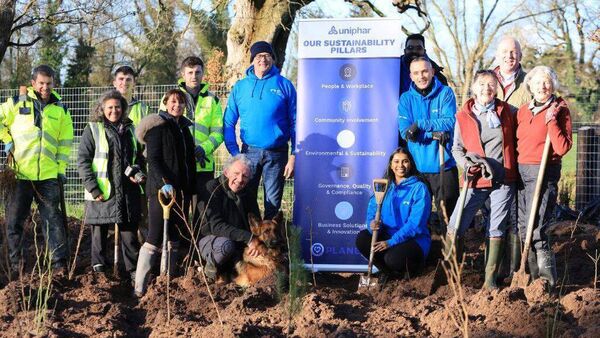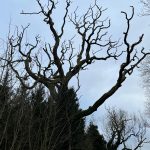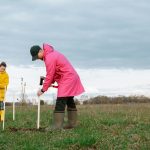
Planting 100 million native trees over the next 10 years
Citizen-led tree campaigns put welcome pressure on local authorities which tend to be slow to act upon greening commitments.
In the heart of winter, things can seem a little bleak. But when we pause to look closely, there are colours, textures, and patterns to be seen in nature that are special to this time of year.
The patterns of tree bark become more apparent in leaflessness. The butter-smooth creamy-coloured bark of young birch trees stands out especially, the pale powdery pigments reflecting light to protect the bark from sunburn. Their trunks are slender and elegant amid the tangle of other species. Distinctive diamond patterning on the bark of poplar and aspen trees is another to look out for.
Walking through parkland on frosty mornings, with the sun blazing warm orange light, twiggy canopies have a distinctively orange hue, almost glowing with warmth despite the temperature. Without their cloak of summer leaves, the branching patterns of each species’ can be seen more readily too.
Colour comes from luminous yellow and lime green lichens coating the branches of old willows and bright mosses standing out against the palette of winter browns.
Elegantly elongated catkins dangle on hazel trees in lively pale greens and yellows. Catkins are the reproductive organs of certain wind-pollinated tree species, including birch, alder, and willow. They are made up of cylindrically arranged clusters of tiny flower buds that will develop over the coming months, dispersing pollen on the breeze before the leaves appear and hinder the path of the pollen. In the case of birch trees, both male and female catkins grow separately on the same tree.
While we admire the appearance of trees in winter, it’s a good time to consider what we can do to ensure the continuity of their presence in the landscape. Planting season lasts till about March, so that new saplings can settle into their new homes before the sap begins to rise in Spring and a new season of growth begins.
In Ireland, we have a gaping deficit of tree cover, especially native trees. So bad is the situation that we have the lowest tree cover in Europe. Meanwhile, the value of trees for landscape, biodiversity, water quality, climate mitigation, and adaptation are finally being recognised. It is thus a welcome phenomenon that so many people are seeking to establish new native woodlands wherever possible.
An old friend of mine, Brother Anthony (now Father Anthony), of Glenstal Abbey in County Limerick, has been avidly planting fruit trees such as plum in byways and hedges for some years now, as future offerings of sweet sustenance for both humans and wild animals.
He and his fellow Benedictine monks in Glenstal Abbey have recently also begun planting 2,500 native trees on Abbey Grounds as part of a nationwide project to plant 100 million native trees on 50,000 mini forests across the country over the next 10 years.
The ‘100 Million Trees project’ is focused on working with landowners such as local authorities, businesses, and householders to establish small areas of densely planted native trees
A substantial new initiative under the Department of Agriculture, Food and the Marine is offering financial support for planting up to one hectare of native trees (up to two hectares if the trees are planted along a watercourse) without the need for a licence.
The ‘New Tree Area Scheme’ is designed to make it as easy as possible for people to plant up small woodlands on suitable land comprising of native species. In order to protect sensitive habitats, such as wetlands, fens, or species-rich semi-natural grassland, the scheme only applies to mineral soils and in areas outside of designated sites.
Figuring out which trees are best suited to the site is crucial, so the woodland has the best chance to thrive for generations to come. The simplest way to do this is to look at what trees are already growing well in similar sites nearly, bearing in mind that native tree species are best for biodiversity. Alder, birch, and willow generally grow well in wet ground, and in heavy clayey soils.
Trees with a generous spring blossom are stunning in Aril and May and especially wonderful for bees and other pollinators. Crab apple, wild cherry, bird cherry, rowan, and hawthorn are all native trees that flower generously in Spring.
And while we tend to think of flowering trees as cherry or apple blossoms, every deciduous tree in world produces flowers of some sort, a prerequisite for reproduction. Oak trees produce flowers in spring, dangling in tassel-like catkins, golden-green and high up in the canopy. Hazel has flowers too — there are the already mentioned yellow flowers, which are male, as well as tiny vivid red flowers on female hazel trees.
Smaller native trees such as spindle and guelder rose are worth becoming familiar with too — stunning little native trees that add wildlife value to any planting scheme. Native evergreens scots pine and holly grow well in almost any environment and add distinctive year-round structure and cover.
Increasing tree cover is equally important in urban environments too, where trees offer far-reaching and wide-ranging benefits to human and non-human inhabitants, from tuneful songbirds to colourful butterflies, bees, and moths.
A community group in Dublin city, going by the name of ‘Trees for the Tenters’, made up of an eager group of volunteers, is actively seeking the support of Dublin City Council to replace street trees that have been cleared in the neighbourhood, as well as pushing the Council to implement plans for greening the area with pockets of layered mini-woodlands. Citizen-led tree campaigns put welcome pressure on local authorities who tend to be slow to act upon greening commitments.
Another aspect that’s always worth bearing in mind if you’re considering establishing some woodland, is that trees have been planting themselves for millions of years! Allowing trees to regenerate naturally is the ideal way of restoring tree cover, and is often what will happen once ground is protected from grazers such as sheep, goats and deer.
Whatever the method, the sooner we allow diverse and native trees to recover lost ground the sooner the benefits will unfold.
View full article at
Planting 100 million native trees over the next 10 years (irishexaminer.com)
If you wish to find out more, please visit our websites




